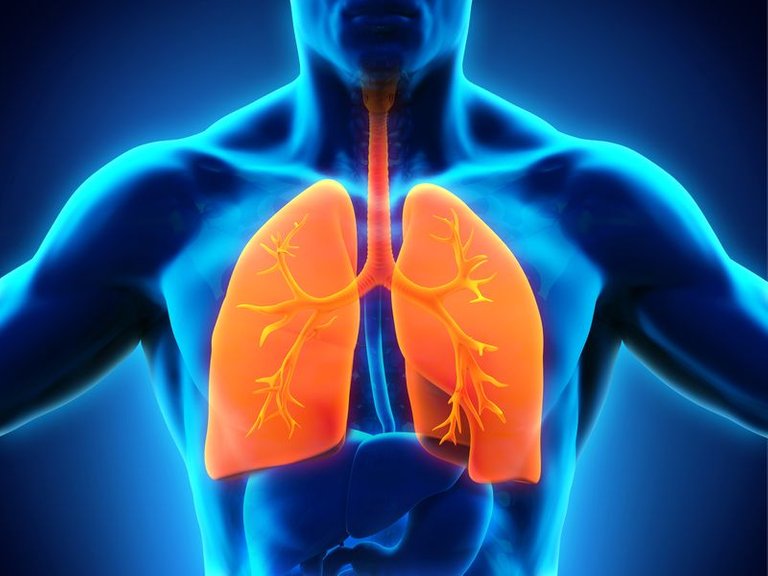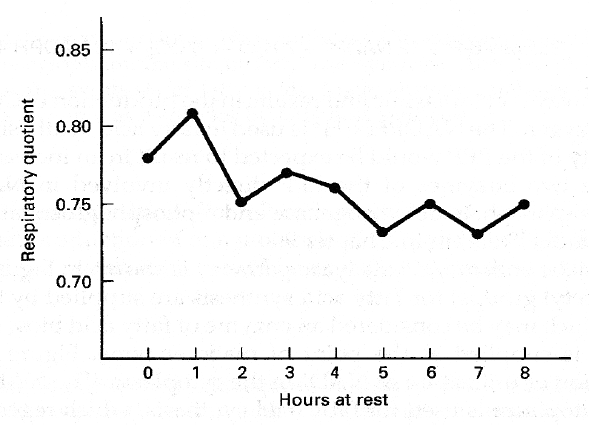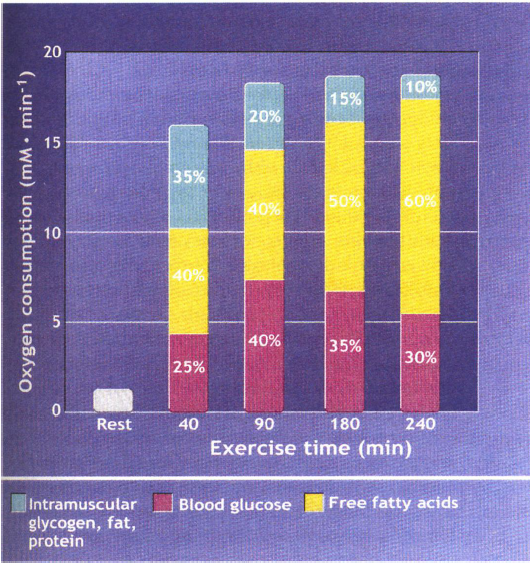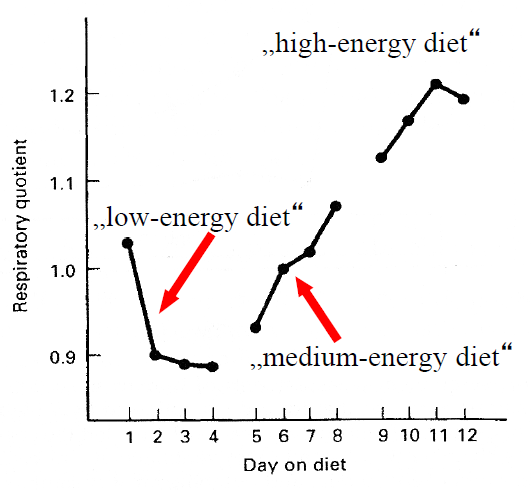This is a follow-up article to the one, where I provided a first introduction to organic specific requirements and interorgan pathways essential for the Human Energy Metabolism (see Part #1). Today I will continue with the:
Respiratory Quotient

Image Source
Let's get started with a definition of the Respiratory Quotient (short RQ):

As we established in the last article, the human body depends on a variety of different fuels like lipids (or fatty acids), carbohydrates or amino acids. The metabolic use, ie the combustion of these fuels has a very specific effect on the RQ:
- Combustion of Carbohydrates gives a RQ = 1
- Combustion of fat yields a RQ = 0.7
- Combustion of a mixture of amino acids has an average RQ = 0.8
Respiratory gases can be measured quite easily and hence the RQ can be experimentally determined. These measurements can be used to calculate the amount of CO2 produced and O2 used by the body over any given period. With this information it is possible to determine the metabolic fuels that are used under resting conditions or various physical activities.
In order to explain where the mentioned characteristic RQ values come from, I provide you with some exemplary calculations:


Since carbohydrats are broken down to monosaccharides (C6H12O6) before they enter glycolysis, it is legit to do the calculation with glucose.

The calculation of the RQ for amino acids is less straightforward since we also have to consider the fate of nitrogen. Furthermore the side chains of the amino acids vary considerable and with them also the RQ.
RQ measurements on a resting human

Under resting conditions the RQ trend indicates a shift away from carbohydrate use toward fat oxidation. The data, that lead to this conclusion are shown in the graph to the right. Periodic RQ-measurements during rest after a one night fast (subject was in bed). However, even after prolonged resting fat is never the sole source of energy.
RQ measurements show shifts upon exercise

RQ-measurement were done prior to exercise, during a 45 min period of bicycling and also in the recovery period. RQ at rest shows that fat is the major source of energy. Exercising increases the RQ sharply, indicating that glycogen, stored in the skeletal muscles, is used as energy source. During recovery the energy metabolism obivously shifts back to fat oxidation.
On the use of macronutrients
The following graphic is taken from Ref.3 and shows the generalized relative contributions of macronutrients used in the catabolism to fuel an exercising human individual. All values are related to the oxygen consumption.

This set of data reflects the previously stated characteristics very well: Upon the start of physical activity the initial source of energy is glucose, first in form of intramusculary stored glycogen, second as blood glucose. Only after extended physical stress the body activates mechanisms to run on fat as major energy source.
Fatty acid biosynthesis influences the RQ
The RQ is not only influenced by the current active catabolic mode but also by anabolism. Under conditions of a positive energy balance, hence uptake of a "high-energy diet", net biosynthesis of fatty acids occurs. In other words, oxidation of fatty acids is overcompensated by fatty acid biosynthesis from acetyl-CoA. This leads to an observable RQ > 1!

The data above show the measured RQ's for humans, which were given a low-, medium- and high-energy diet for a 4-day period each. It was found that the RQ increases with the energy uptake in the diet. This indicates net fatty acid biosynthesis. But how can this be explained?
Fatty acid biosynthesis requires NADPH, which is mainly provided by the following two reactions:

As you can see, these processes are coupled with a release of carbon dioxide, which leads to an increased RQ under a high calory regime.
Conclusions from RQ studies
- At rest, β-oxidation of fatty acids is the major source of energy.
- When exercising, the body starts utilizing glucose.
- However, with prolonged exercising, glycogen stores run out and the body resumes β-oxidation of fatty acids as a prime energy source.
I hope you enjoyed the insight I provided with my second post on the Human Energy Metabolism. I will continue with this topic with one of my next articles again. Then I will turn towards some quite specific aspects like metabolic diseases and obesity. - So stay tuned!
mountain.phil28
References:
- A Science Direct Review Collection
- A Wikipedia Article
- McArdle, Katch & Katch: Exercise physiology
- Further information and non-direct-cited images are taken from
"Molecular Physiology" lectures at the TU Graz.
click here.Congratulations @mountain.phil28, this post is the sixth most rewarded post (based on pending payouts) in the last 12 hours written by a User account holder (accounts that hold between 0.1 and 1.0 Mega Vests). The total number of posts by User account holders during this period was 3429 and the total pending payments to posts in this category was $6264.99. To see the full list of highest paid posts across all accounts categories,
If you do not wish to receive these messages in future, please reply stop to this comment.
In elementary school I passed 3 circles of some competition in chemistry and physics too. During my first year in high school I loved chemistry, but from 2nd year I ignored it (didn't hate it :) ). Now, thanks to you, I am starting to change and see it with different eyes.
Very educational posts, keep 'em coming, and crossings with biology and human body is amazing. Everything looks so simple when you explain it ;)
Cheers!
I am delighted to get that kind of response. ;)
Unfortunately I just ended my series on the - in my opinion very interesting - Human Energy Metabolism, partially due to a lack of feedback. But still, I will turn to other topics combining chemistry, biology and technology. So stay tuned. ;)
Best,
mountain.phil28
It's sounds like lazy people who want to be less fat are better off just laying on the couch then only doing alittle bit of exercise if You have to go hard to get back to that fatty acid oxidation ;) I think I used a similar method to measure yeast activity in a college chem lab on fermentation. Thanks for the refresh I'm sure ill use this sometime as my experiments get more in depth.
One question, what is the difference between the initialy used glucose and blood glucose?
Great, that you like the post. :) Ha! You may have used some derivative of this. xD
Mhmmm.. I am not sure, what 'difference' you want to have discussed here. But here a some: The first major difference is, that the glucose stored in the muscle is already there were it is meant to be used, so it does not take a delivery, which may be a further limiting factor. This is especially important for very spontaneous workload! Second, the sugar stored in the muscle is stored as glycogen, so as an branched carbohydrate with a whole lot of 'reductive ends', which are necessary for its fast availability, since the degradation of the glycogen starts and proceeds on these ends. Have a look at the following image, where glycogen is shown:
Structure of Glycogen - Image Source
This is the way how glycogen is built up. A protein core acts as a kind of a "growing seed" and then the glucose molecules are condensed together having a lot of branches, to provide for a great numbers of ends. The blood glucose does not have such a complex structure. - At least to my knowledge.
I hope your question is answered. Otherwise I look forward to a more specified one. ;)
Best,
mountain.phil28
Congratulations @mountain.phil28! You have completed some achievement on Steemit and have been rewarded with new badge(s) :
Click on any badge to view your own Board of Honor on SteemitBoard.
For more information about SteemitBoard, click here
If you no longer want to receive notifications, reply to this comment with the word
STOPGreat breakdown, I love how simply you make everything tie together on what can be such a hard biochemical topic!
Thank you very much! - I really love to hear this! 🤗
Good post bro
chemistry make me mad brother, but a informative post indeed.
well done sugar :D💖 i cant even nitpick :p LOL
side note, sugar gets a slower digestion time when fat is added/around.
(-the bloodglucose is not counted/mesured into the muscleglycogen but will after bloodsugar crashes get converted to glucos to help the bloodsuger to race up